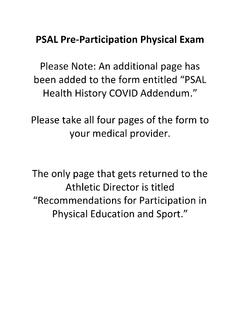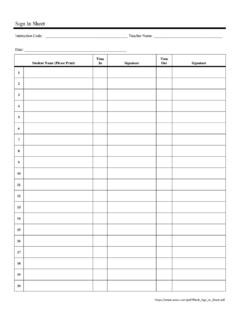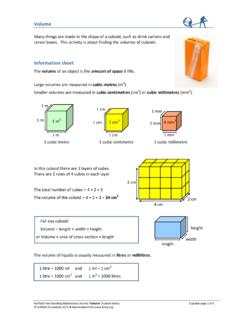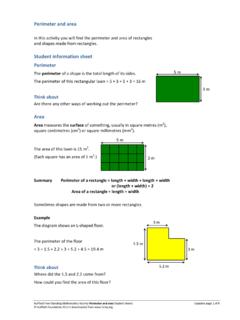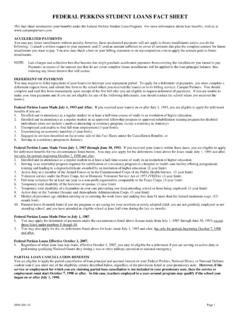Transcription of Student and Parent Information Sheet - PSAL
1 Concussions: The Invisible Injury Student and Parent Information Sheet Concussion definition A concussion is a reaction by the brain to a jolt or force that can be transmitted to the head by an impact or blow occurring anywhere on the body. Essentially a concussion results from the brain moving back and forth or twisting rapidly inside the skull. Facts about concussions according to the Center for Disease Control (CDC) Symptoms An estimated 4 million people under age 19 sustain a head injury annually. Of these approximately 52,000 die and 275,000 are hospitalized. An estimated 300,000 sports and recreation related concussions occur each year. students who have had at least one concussion are at increased risk for another concussion. In New York State in 2009, approximately 50,500 children under the age of 19 visited the emergency room for a traumatic brain injury and of those approximately 3,000 were hospitalized.
2 Requirements of School Districts: Education: Each school coach, physical education teacher, nurse, and athletic trainer will have to complete an approved course on concussion management on a biennial basis, starting with the 2012-2013 school year. PSAL Coaches must complete the PSAL Concussion Management course Information : Provide concussion management Information and sign off with any parental permission form. The concussion management and awareness Information or the PSAL web site must be made available on the school web site, if one exists. Removal from athletics: Require the immediate removal from athletic activities of any pupil that has or is believed to have sustained a mild traumatic brain injury. No pupils will be allowed to resume athletic activity until they have been symptom free for 24 hours and have been evaluated by and received written and signed authorization from a licensed physician.
3 For interscholastic athletics, clearance must come from the school medical director. Symptoms of a concussion are the result of a temporary change in the brain s function. In most cases, the symptoms of a concussion generally resolve over a short period of time; however, in some cases, symptoms will last for weeks or longer. Children and adolescents are more susceptible to concussions and take longer than adults to recover. It is imperative that any Student who is suspected of having a concussion is removed from athletic activity ( recess, PE class, sports) and remains out of such activities until evaluated and cleared to return to activity by a physician. Symptoms include, but are not limited to: Decreased or absent memory of events prior to or immediately after the injury, or difficulty retaining new Information Confusion or appears dazed Headache or head pressure Loss of consciousness Balance difficulties, dizziness, or clumsy movements Double or blurry vision Sensitivity to light and/or sound Nausea, vomiting and/or loss of appetite Irritability, sadness or other changes in personality Feeling sluggish, foggy or light-headed Concentration or focusing problems Drowsiness Fatigue and/or sleep issues sleeping more or less than usual students who develop any of the following signs, or if signs and symptoms worsen, should be seen and evaluated immediately at the nearest hospital emergency room.
4 Headaches that worsen Seizures Looks drowsy and/or cannot be awakened Repeated vomiting Slurred speech Unable to recognize people or places Weakness or numbing in arms or legs, facial drooping Unsteady gait Change in pupil size in one eye Significant irritability Any loss of consciousness Suspicion for skull fracture: blood draining from ear or clear Such authorization must be kept in the pupil s permanent heath record. Schools shall follow directives issued by the pupil s treating physician. fluid from the nose PSAL s Guidance for Concussion Management Concussion Management Team Schools are advised to develop a written concussion management policy. A sample policy is available on the PSAL website at The policy should include: A commitment to reduce the risk of head injuries. A procedure and treatment plan developed by the district medical director.
5 A procedure to ensure proper education for school nurses, certified athletic trainers, physical education teachers, and coaches. A procedure for a coordinated communication plan among appropriate staff. A procedure for periodic review of the concussion management program. Schools may, at their discretion, form a concussion management team to implement and monitor the concussion management policy and program. The team could include, but is not limited to, the following: students parents /Guardians School Administrators Medical Director Private Medical Provider School Nurse Director of Physical Education and/or Athletic Director Certified Athletic Trainer Physical Education Teacher and/or Coaches Classroom Teachers Return to Learn and Return to Play Protocols Other Resources Cognitive Rest: Activities students should avoid include, but are not limited to, the following: Computers and video games Television viewing Texting Reading or writing Studying or homework Taking a test or completing significant projects Loud music Bright lights students may only be able to attend school for short periods of time.
6 Accommodations may have to be made for missed tests and assignments. Physical Rest: Activities students should avoid include, but are not limited to, the following: Contact and collision High speed, intense exercise and/or sports High risk for re-injury or impacts Any activity that results in an increased heart rate or increased head pressure Return to Play Protocol once symptom free for 24 hours and cleared by School Medical Director: Day 1: Low impact, non strenuous, light aerobic activity. Day 2: Higher impact, higher exertion, moderate aerobic activity. No resistance training. * New York State Department of Health concussion/htm l New York State Public High School Athletic Association l Center for Disease Control and Prevention l National Federation of High Schools The FREE Concussion Management course does not meet education requirement.
7 L Child Health Plus l Local Department of Social Services New York State Department of Health l Brain Injury Association of New York State- l Nationwide Children s Hospital Concussions in the Classroom l Upstate University Hospital Concussions in the Classroom l ESPN Video Life Changed by Concussion l Day 3: Sport specific non-contact activity. Low resistance weight training with a spotter. Day 4: Sport specific activity, non-contact drills. Higher resistance weight training with a spotter. Day 5: Full contact training drills and intense aerobic activity. Day 6: Return to full activities with clearance from School Medical Director. Any return of symptoms during the return to play protocol, the Student will return to previous day s activities until symptom free. l American Association of Neurological Surgeons and%20 l Consensus Statement on Concussion in Sport Zurich PSAL djd/dp 8/12

